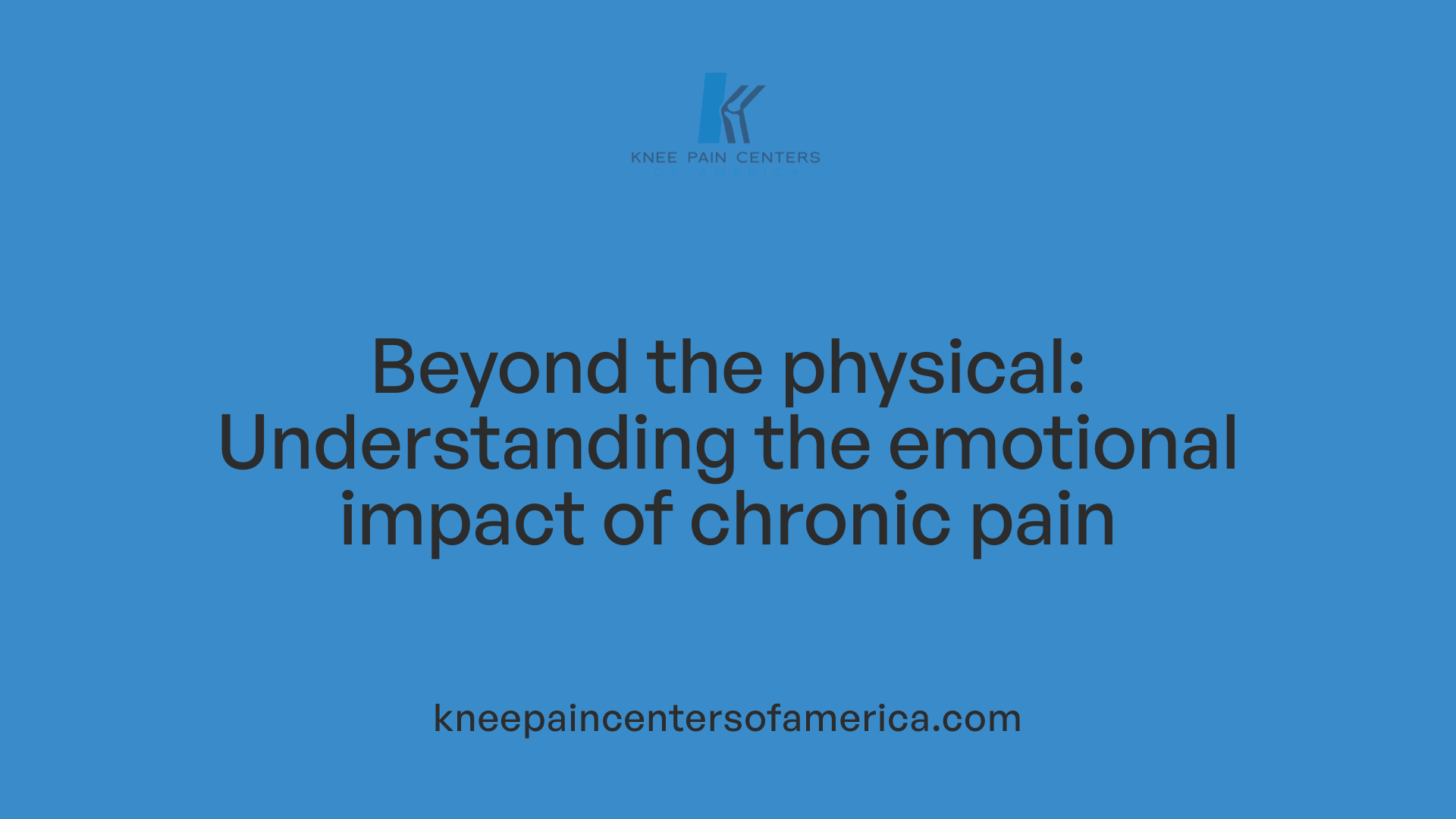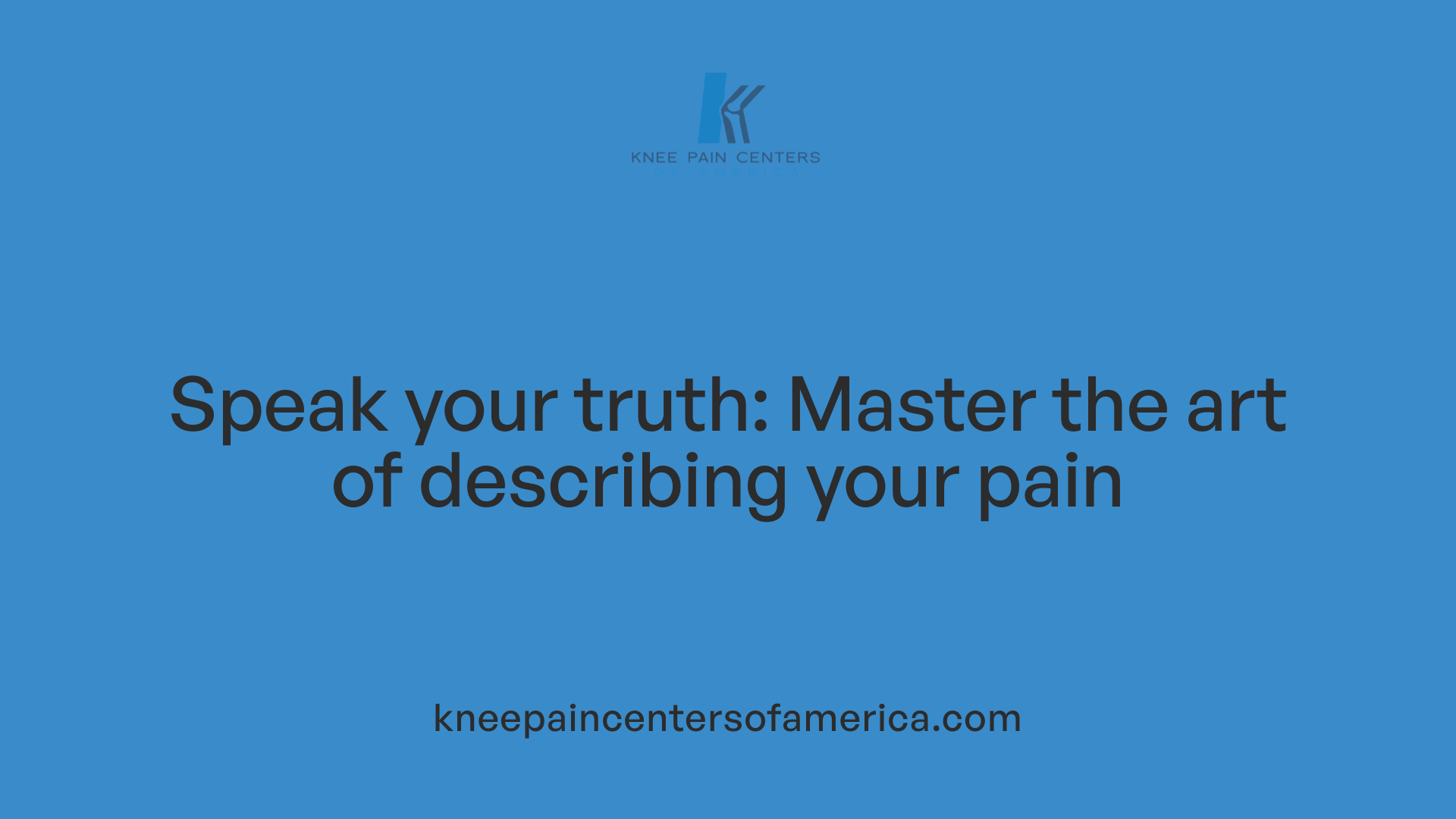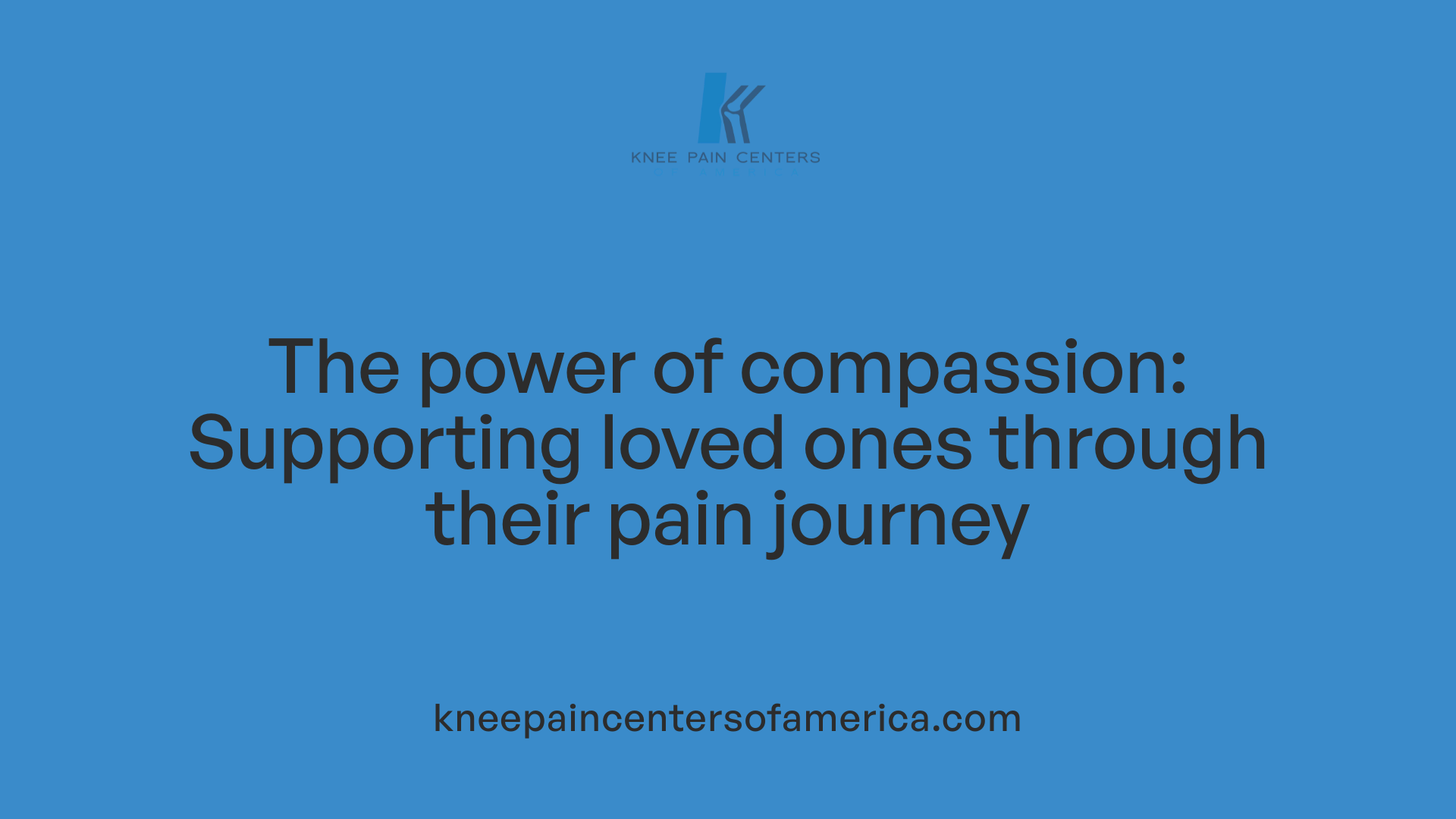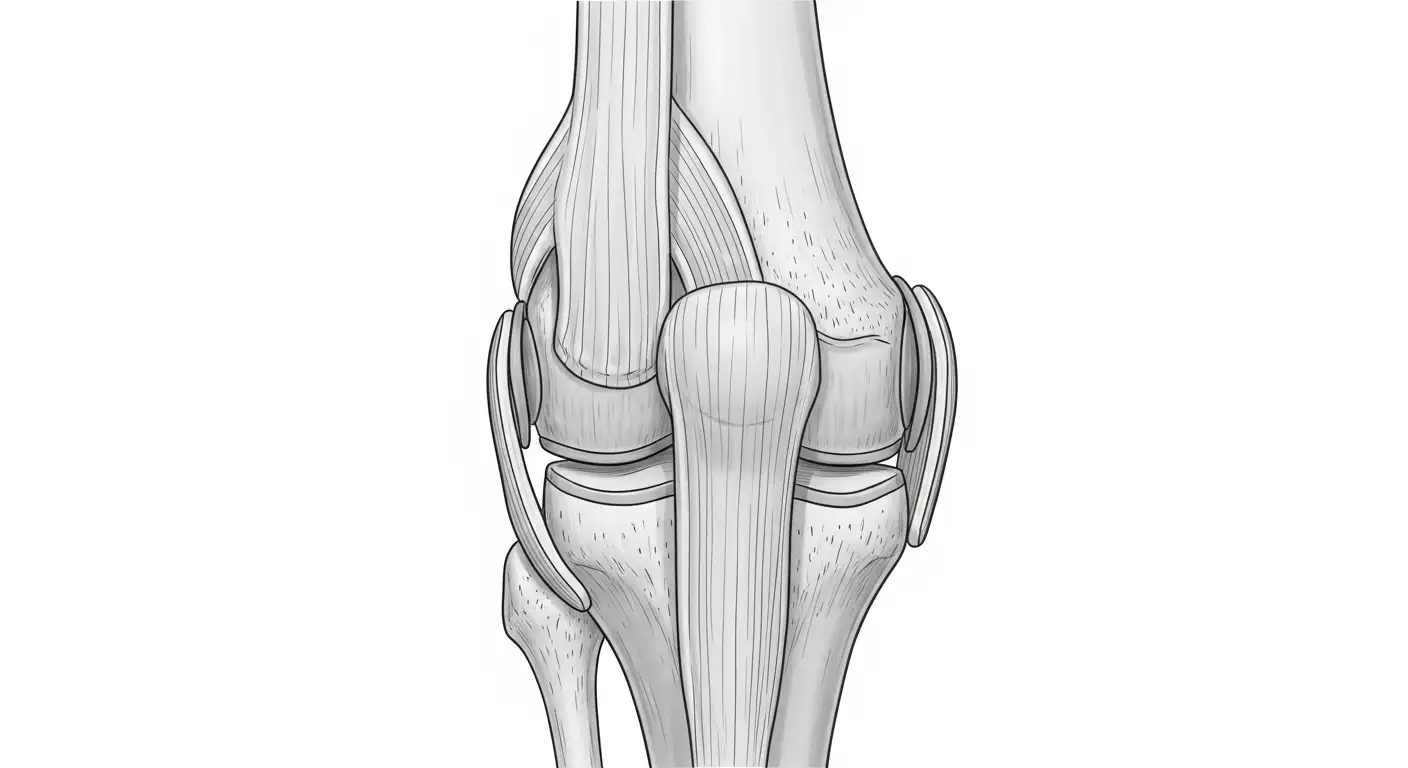The Hidden Burden of Chronic Pain Beyond Physical Discomfort
Chronic pain, defined as pain lasting longer than three months, extends far beyond physical discomfort, significantly impacting mental health and emotional well-being. Its persistent nature interferes with daily life, relationships, and self-worth, often leading to a cycle of emotional distress. Recognizing, understanding, and managing these emotional challenges are crucial steps towards improving quality of life for those affected.
The Psychological and Emotional Consequences of Chronic Pain

How does chronic pain affect mental health and emotional well-being?
Living with chronic pain goes far beyond the physical sensation. It deeply affects mental health and emotional stability. Studies reveal that individuals experiencing long-term pain are four to five times more likely to develop mental health issues such as depression and anxiety. This high prevalence is tied to the relentless stress of ongoing discomfort, sleep disruptions, and the emotional and psychological toll of coping with persistent pain.
The impact on mood can be profound, leading to feelings of hopelessness, irritability, and emotional volatility. People with chronic pain often find their energy levels and ability to focus diminished, which further adds to their emotional distress. The biological connection between pain and mental health is complex, involving shared brain pathways and neurochemical changes that reinforce each other.
Furthermore, many suffer from untreated psychological symptoms because mental health care is often overlooked in pain management plans. This gap can intensify feelings of isolation, despair, and helplessness.
Effective treatment approaches require integrating physical and emotional care. Therapies such as cognitive-behavioral therapy (CBT), medication, lifestyle adjustments, and support systems are all crucial in addressing the intertwined nature of chronic pain and mental health issues.
Common emotional responses to chronic pain
Individuals living with long-term pain frequently grapple with a range of emotional responses. Anxiety is common as they worry about the unpredictability of pain episodes. Mood swings, irritability, and anger may surface due to feeling misunderstood or frustrated with their limitations.
Many also experience feelings of sadness, guilt, or shame, especially if their pain affects relationships or work life. These emotions can contribute to social withdrawal, further heightening feelings of loneliness and depression.
The emotional response is often shaped by a person’s beliefs about their pain, their support network, and their coping strategies. Negative thought patterns like catastrophizing—believing pain will worsen or lead to catastrophic outcomes—can intensify emotional distress.
Addressing these emotional responses involves not only managing pain physically but also recognizing and validating feelings. Psychological therapies, peer support, and mindfulness practices are effective tools to help patients process their emotions healthily.
Risk of depression, anxiety, and mood swings
Chronic pain significantly elevates the risk of developing mental health conditions such as depression, generalized anxiety disorder, and mood swings. The constant feeling of discomfort combined with frustration over limitations can lead to feelings of helplessness and despair.
Anxiety often arises from concerns about future pain episodes, treatment uncertainties, or the impact on loved ones. Mood swings may be a reaction to hormonal or neurochemical changes associated with chronic pain, which can further impair emotional regulation.
This interconnected cycle can make managing either condition more challenging. Recognizing early signs of depression or anxiety is crucial for timely intervention. Treatments such as counseling, medication, and support groups are vital components of a comprehensive pain management plan.
In sum, chronic pain’s influence extends beyond physical discomfort, deeply affecting emotional and psychological health. Acknowledging and addressing these aspects is essential for improving overall quality of life for those affected.
Communicating Your Pain Effectively with Healthcare Providers
 When managing chronic pain, effective communication with healthcare professionals is crucial. Proper pain assessment strategies help providers understand the severity, location, and impact of the pain, enabling them to tailor treatment plans accordingly.
When managing chronic pain, effective communication with healthcare professionals is crucial. Proper pain assessment strategies help providers understand the severity, location, and impact of the pain, enabling them to tailor treatment plans accordingly.
One essential aspect of communication is using descriptive language about pain. Patients should specify where the pain is located, how it feels, and when it occurs. Descriptive words such as burning, aching, stabbing, throbbing, or shooting can provide a clearer picture. Mentioning if pain is constant or intermittent, and whether it worsens during certain activities or at specific times, offers valuable insight.
Pain assessment tools, like the Brief Pain Inventory (BPI) or the Wong-Baker Faces Pain Scale, can help quantify pain intensity and its interference with daily functions. Employing these tools, along with detailed descriptions, helps healthcare providers gauge the effectiveness of treatments and make informed decisions.
Addressing misconceptions and biases is also vital. Patients should openly share their experiences without fear of dismissal—especially since some individuals face implicit bias, which may lead to undertreatment, particularly among minorities or those with invisible pain. Clear communication involves describing symptoms thoroughly and advocating for oneself, including seeking second opinions if necessary.
Understanding how to describe pain effectively, combined with awareness of potential biases, empowers patients to participate actively in their care. This collaborative approach enhances the chances of achieving better pain management outcomes and improving overall quality of life.
| Aspect | Details | Purpose |
|---|---|---|
| Pain assessment strategies | Use of standardized tools like BPI, pain scales, descriptive words | Quantify pain and its impact |
| Descriptive language | Location, quality, timing, triggers | Convey detailed symptom profile |
| Addressing misconceptions | Challenging unhelpful beliefs, advocating for proper care | Improve understanding and treatment |
| Considering biases | Recognize and counteract implicit biases | Ensure fair and adequate care |
Being prepared with this knowledge allows patients to communicate their needs effectively, fostering a stronger partnership with healthcare providers.
Self-Help Strategies for Emotional Resilience
What practical tips can help individuals cope with emotional distress caused by chronic pain?
Living with chronic pain often brings about a range of emotional challenges, including feelings of frustration, sadness, anxiety, and hopelessness. Managing these emotions is crucial to improve overall well-being and maintain a better quality of life.
One of the most effective ways to cope with emotional distress is through relaxation techniques. Practices such as deep breathing exercises, progressive muscle relaxation, guided imagery, and meditation can significantly reduce stress hormones and neurochemical imbalances associated with pain and emotional upset. Consistently incorporating these methods into daily routines helps calm the mind and body, fostering a sense of control and calmness.
Mindfulness and meditation are also powerful tools for emotional resilience. Mindfulness involves paying focused attention to the present moment without judgment, which can reduce anxiety about past or future pain episodes. Meditation practices, including guided meditation or mindfulness-based stress reduction (MBSR), have been shown to lessen pain perception and improve mood by promoting relaxation and mental clarity.
Physical activity offers additional benefits for emotional health. Gentle movements such as yoga, tai chi, or walking can release endorphins—biological chemicals that act as natural painkillers and mood enhancers. Regular, low-impact exercise not only helps manage pain but also combats symptoms of depression and anxiety, enhancing overall emotional resilience.
Setting realistic goals and pacing activities prevents overexertion, which can lead to flare-ups and increased feelings of frustration. Breaking tasks into smaller, manageable steps allows individuals to experience successes without overwhelming themselves, fostering a sense of achievement and control.
Building a supportive network is equally important. Connecting with friends, family members, or support groups provides emotional validation and understanding. Sharing experiences can eliminate feelings of isolation and promote coping strategies learned from others facing similar challenges.
Addressing mental health concerns directly through counseling or cognitive-behavioral therapy (CBT) can be transformative. These therapies help identify and modify unhelpful thought patterns, such as catastrophizing or black-and-white thinking, which often exacerbate emotional distress.
Practicing good sleep hygiene, such as maintaining consistent sleep routines and avoiding stimulants before bedtime, improves restorative sleep, which is vital for emotional regulation. Incorporating gratitude exercises and focusing on positive aspects of life helps shift attention from pain and frustration to resilience and hope.
In summary, practical self-help strategies include adopting relaxation and mindfulness practices, engaging in gentle physical activity, pacing tasks, building strong support systems, and seeking professional mental health support when needed. These approaches collectively enhance emotional resilience, making it easier to cope with the ongoing challenges of chronic pain.
Managing Stress and Emotions during Flare-Ups
What strategies can help manage the emotional toll of chronic pain?
Managing the emotional impact of chronic pain requires a comprehensive approach centered on understanding and accepting one's experiences. Techniques such as emotional approach coping (EAC) encourage individuals to process, express, and understand their feelings, which can reduce emotional distress and improve adaptation.
Mindfulness practices, relaxation exercises, and breathing techniques are valuable tools to decrease physiological stress and emotional tension. These methods promote calmness, help regulate mood swings, and lessen the intensity of pain perception.
Engaging in gentle activities during flare-ups is vital. Instead of pushing through severe pain, individuals are encouraged to accept the increased discomfort, adjust their activities, and incorporate pacing strategies. This balanced approach prevents overexertion and promotes recovery while maintaining a sense of control.
Practicing mindfulness and self-compassion during challenging episodes can be particularly effective. Mindfulness fosters present-moment awareness, allowing individuals to observe their pain and emotions without judgment. Coupled with self-compassion, this approach reduces feelings of frustration and discouragement.
In addition to these techniques, psychological therapies like cognitive-behavioral therapy (CBT) and acceptance and commitment therapy (ACT) are recommended. They help reframe unhelpful thoughts, address negative beliefs about pain, and promote adaptive emotional processing.
Supporting oneself during flare-ups involves adhering to routines that include restful activities, maintaining social connections, and seeking emotional support when needed. Recognizing the transient nature of pain episodes and approaching them with kindness can mitigate emotional distress.
In sum, managing the emotional toll during flare-ups involves accepting the pain, engaging in gentle, mindful movement, and cultivating self-compassion. These strategies can help maintain emotional balance, reduce stress, and enhance overall quality of life.
Impact of External Factors on Pain and Emotions
How does chronic pain influence daily life and personal relationships?
Chronic pain extends beyond physical discomfort, significantly affecting a person’s daily routines and personal relationships. Individuals experiencing ongoing pain often find their energy levels diminished, making simple activities challenging. This can lead to a reduction in work participation and social activities, fostering feelings of isolation.
Emotionally, chronic pain can cause episodes of anxiety, depression, and helplessness. These emotional responses may strain existing relationships, as individuals may become irritable, withdraw from loved ones, or require additional support. Family members and friends may also find it difficult to cope with the ongoing situation, which can exacerbate tensions and misunderstandings.
The psychological burden of pain often results in a complex interplay of decreased intimacy and emotional disconnect within relationships. For example, reduced physical intimacy, altered routines, and perceived emotional distance can harm bonds.
Effective communication about pain and its effects, alongside education for family members, can make a significant difference. Support strategies such as counseling, shared coping skills, and fostering understanding can help maintain strong relationships.
Ultimately, managing emotional and social impacts through therapy, support groups, and open dialogue can help improve quality of life for those living with chronic pain and their loved ones.
Support systems
Support from healthcare professionals, family, friends, and peer groups plays a crucial role in managing the emotional and social consequences of chronic pain. Building a strong support network can lessen feelings of isolation and provide practical assistance in daily activities.
Cultural and spiritual influences
Cultural beliefs shape how individuals perceive and respond to pain. Spiritual practices, like prayer or meditation, often offer comfort, enhance coping, and improve pain tolerance. For some, spirituality provides a sense of purpose and connection that fosters resilience.
Health disparities and bias
Access to effective pain management can be uneven, influenced by social, economic, and systemic factors. Biases—whether implicit or explicit—affect healthcare providers' attitudes, potentially leading to undertreatment or dismissiveness toward certain populations, particularly minorities. This disparity not only worsens health outcomes but also increases feelings of mistrust and helplessness among marginalized groups.
| External Factors | Influence on Pain and Emotions | Additional Context |
|---|---|---|
| Support Systems | Provide emotional comfort, assist with daily routines, foster resilience. | Family, friends, healthcare, peers |
| Cultural & Spiritual Beliefs | Shape pain perception, offer coping mechanisms, foster a sense of hope. | Prayer, meditation, community practices |
| Health Disparities & Bias | Lead to unequal treatment, influence pain management, affect trust. | Systemic inequality, implicit bias |
Understanding these external influences helps tailor holistic approaches, addressing not only physical symptoms but also emotional well-being and social integration.
Supporting Loved Ones and Caregivers

How can family support and validation help someone living with chronic pain?
Family support plays a vital role in the emotional and practical management of chronic pain. When loved ones validate the individual's experience, it helps reduce feelings of isolation and misunderstanding. Validating their feelings and acknowledging the reality of their pain fosters a supportive environment where the person feels accepted and cared for.
Supporting loved ones involves understanding the nature of chronic pain, which is often invisible but profoundly impactful. Showing empathy, listening without judgment, and avoiding dismissive comments about their pain can boost their emotional resilience.
Family members can also help by encouraging healthy routines and engaging in activities that promote well-being, such as gentle exercises, pacing tasks to avoid fatigue, and supporting good sleep habits. This collective effort contributes to better mental health and helps the individual feel supported in their journey.
How to encourage activity and routines while managing pain?
Encouraging activity is essential but must be balanced carefully to avoid flare-ups. Practical techniques include pacing activities—breaking tasks into manageable parts—and spacing them out to prevent exhaustion.
Setting realistic, achievable goals helps build confidence and a sense of accomplishment. Supporting routine behaviors like regular sleep, balanced nutrition, and gentle movement (such as walking or yoga) can improve energy levels and mood.
During flare-ups, adopting a mindset of acceptance and applying mindfulness can help individuals avoid feelings of frustration or guilt. It's important to promote self-compassion and remind them that activity, even if limited, remains beneficial.
What role does advocacy and education play in supporting chronic pain management?
Advocacy and education are crucial in empowering individuals and their families. Learning about chronic pain helps dispel misconceptions and promotes proper understanding.
Supporting patients involves advocating for access to comprehensive pain management services, including physical therapy, mental health support, and alternative therapies.
Educational resources, such as self-help guides and workshops on cognitive behavioral techniques, teach practical skills like stress management, goal setting, and relaxation exercises.
Participating in support groups—either locally or online—offers shared experiences, emotional validation, and collective advocacy for better healthcare policies.
What resources are available for living with chronic pain and maintaining emotional well-being?
People living with chronic pain can find a wealth of educational and emotional support resources. Self-help guides and online courses often provide strategies for pacing, stress reduction, and confronting negative thoughts.
Support groups and peer networks allow individuals to share experiences and coping strategies, which helps diminish feelings of loneliness.
Healthcare professionals such as psychologists and pain specialists can offer therapy options like cognitive behavioral therapy (CBT), which addresses emotional challenges such as anxiety and depression.
Families and caregivers should also seek guidance through informational sessions and counseling to better support their loved ones. These combined efforts foster resilience and promote a balanced emotional state.
| Support Area | Description | Tools & Resources |
|---|---|---|
| Family Support | Emotional validation, understanding, encouragement | Support groups, counseling, educational materials |
| Activity & Routine | Pacing, goal setting, gentle movement | Self-help guides, physical therapy, community programs |
| Advocacy & Education | Increasing awareness, access to care, empowerment | Workshops, online forums, advocacy campaigns |
| Emotional & Mental Health Support | Addressing anxiety, depression, and stress | CBT, mindfulness, support groups, counseling |
This comprehensive approach to supporting loved ones with chronic pain emphasizes understanding, encouragement, and access to resources, all crucial in fostering emotional well-being amid ongoing physical challenges.
The Role of Lifestyle and Complementary Therapies
How can therapeutic approaches like cognitive-behavioral therapy (CBT) assist in coping with chronic pain?
Cognitive-behavioral therapy, or CBT, offers valuable tools for managing the emotional and psychological toll of chronic pain. This therapy helps individuals recognize and challenge unhelpful thoughts such as catastrophizing, black-and-white thinking, or feelings of helplessness, which can amplify pain perception. By altering these thought patterns, people can develop healthier coping strategies and reduce feelings of despair or frustration.
CBT also incorporates practical techniques like relaxation exercises, deep breathing, meditation, and biofeedback. These methods are effective in decreasing stress and muscle tension, which often worsen pain symptoms. Mindfulness-based stress reduction (MBSR) and Acceptance and Commitment Therapy (ACT) are variations of psychological approaches that promote acceptance of pain and focus on living according to personal values, rather than fighting or resisting discomfort.
In addition to mental health benefits, these therapies often involve lifestyle modifications such as pacing activities, goal setting, and building a support network. Proper application of CBT can lead to improved emotional well-being, reduced reliance on medications, and enhanced ability to maintain daily activities despite ongoing pain. Ultimately, psychological support significantly alleviates the emotional burden of chronic pain, fostering resilience and better overall quality of life.
Mind-body practices
Engaging in mind-body techniques can be highly effective for managing chronic pain. Practices like yoga, tai chi, meditation, and guided imagery relax muscles, reduce inflammation, and improve mood. Regular practice helps increase body awareness and fosters a sense of control over pain sensations. These methods also promote relaxation, which can decrease stress hormone levels that exacerbate pain.
Spirituality and purpose
For many, spirituality provides a source of meaning, hope, and connectedness, which can be invaluable when coping with long-term pain. Spiritual practices such as prayer, meditation, or participation in faith communities may improve pain perception and tolerance by enhancing emotional resilience. Having a sense of purpose and connection often fosters a positive outlook, helping individuals navigate their pain more effectively.
Alternative medicine options
Complementary medicine approaches are diverse and may include herbal remedies, acupuncture, massage therapy, chiropractic care, and nutritional supplements. These practices aim to reduce pain while supporting overall health. The effectiveness of some alternative treatments varies, and it is crucial to consult healthcare professionals before starting any new therapy. Integrating these approaches with conventional treatments can provide a holistic approach, addressing physical, emotional, and spiritual needs.
| Therapy Type | Description | Purpose |
|---|---|---|
| Cognitive-Behavioral Therapy | Psychological approach to challenge negative thoughts and develop coping skills | Reduce emotional distress, enhance resilience |
| Mind-body practices | Yoga, tai chi, meditation, imagery | Relax muscles, lower inflammation, reduce stress |
| Spirituality and purpose | Faith-based practices, meditation, community involvement | Provide meaning, hope, and emotional strength |
| Alternative medicine options | Acupuncture, herbal remedies, massage, chiropractic care | Alleviate pain, support holistic health |
Understanding and applying these various therapies can empower individuals living with chronic pain. Utilizing a combination of mind-body techniques, spiritual engagement, and safe complementary treatments helps manage pain more effectively, improve mental health, and foster a sense of control and well-being.
How factors influence the pain experience
Every person perceives pain differently, influenced by factors like age, gender, cultural background, and social environment. Emotional responses—such as frustration, anger, or feelings of being misunderstood—further shape how pain is experienced and managed. Recognizing these factors aids in tailoring approaches that address both the physical and emotional aspects of pain.
Living with chronic pain often affects identity and relationships. Feelings of decreased self-efficacy, self-worth, and social isolation are common, especially when pain is invisible. Family dynamics can also shift, causing stress and resentment. Support from loved ones, understanding, and effective communication can help alleviate some of these challenges.
In managing chronic pain, addressing emotional responses and recognizing the influence of social and cultural factors are crucial steps toward improving overall quality of life and fostering resilience in the face of ongoing discomfort.
The Interconnected Cycle of Pain and Emotions
How does chronic pain influence daily life and personal relationships?
Living with chronic pain extends beyond physical discomfort. It significantly affects various aspects of daily life and relationships. Individuals often experience limitations in movement and activity, which can lead to feelings of frustration and loss of independence.
Emotionally, chronic pain can result in anxiety, depression, and feelings of helplessness. These emotional responses may cause social withdrawal, further reducing social interactions and support networks.
Within personal and family relationships, the impact can be profound. Chronic pain may reduce participation in shared activities, leading to misunderstandings or feelings of resentment among loved ones. Intimacy might decrease due to physical discomfort or emotional distress, which can strain relationships.
Family members and caregivers often find themselves managing their own emotional burdens while supporting their loved ones. This cycle of emotional and physical strain can magnify feelings of isolation and stress.
Effective communication and education about the condition play vital roles in mitigating these effects. Support strategies like counseling, support groups, and joint educational sessions can help improve understanding and strengthen relationships.
By acknowledging the complex ways chronic pain influences lives, interventions can be better tailored to enhance quality of life, fostering resilience within individuals and their social circles.
Biological mechanisms linking pain and emotions
Chronic pain triggers increased release of stress hormones and neurochemicals that influence mood and behavior. This biological response can exacerbate feelings of anxiety and depression, creating a feedback loop that worsens pain perception.
Impact on identity and self-esteem
Chronic pain can challenge an individual’s sense of self. When pain impairs roles or activities that define personal identity, such as work or hobbies, it can diminish self-efficacy and self-worth. Invisible pain often leads to feelings of being misunderstood, fueling emotional distress.
Effects on family dynamics
The presence of chronic pain can alter family functioning. It may lead to increased stress, financial strain, and changes in intimacy or caregiving roles. Some family members might experience resentment or helplessness, highlighting the need for emotional support and clear communication.
| Aspect | Impact | Additional Notes |
|---|---|---|
| Daily Life | Activity limitation, emotional distress | Reduced independence, social withdrawal |
| Personal Relationships | Strain, misunderstandings, decreased intimacy | Emotional and physical exhaustion |
| Mental Health | Anxiety, depression, stress | Can worsen pain perception |
| Family Dynamics | Resentment, financial issues, role changes | Importance of support and understanding |
Understanding these interconnected aspects underscores the importance of holistic approaches to managing chronic pain. Addressing physical symptoms alone is often insufficient; emotional and relational support are crucial for improving overall well-being.
Conclusion and Call to Action

How can therapeutic approaches like cognitive-behavioral therapy (CBT) assist in coping with chronic pain?
CBT plays a vital role in managing the psychological impact of chronic pain. It helps individuals identify negative thought patterns such as catastrophizing—a tendency to expect the worst—or feelings of helplessness. By challenging these unhelpful thoughts, individuals can develop healthier perspectives that reduce emotional distress.
In addition to restructuring thoughts, CBT teaches practical skills like relaxation techniques, including deep breathing and meditation, which can alleviate muscle tension and reduce pain perception. Mindfulness-based stress reduction (MBSR) and Acceptance and Commitment Therapy (ACT) are often integrated into pain management, encouraging acceptance of pain and fostering engagement with meaningful activities.
CBT also emphasizes lifestyle adjustments, such as pacing activities, setting achievable goals, and building support networks. These strategies improve emotional resilience, enabling individuals to live better with ongoing pain while reducing dependence on medications or invasive procedures.
Overall, incorporating psychological therapies into a comprehensive treatment plan helps lessen the emotional burden, enhance mental health, and promote a better quality of life despite persistent pain.
Why is emotional support and resilience crucial in managing chronic pain?
Living with chronic pain often leads to feelings of frustration, sadness, and isolation. Emotional support from loved ones, healthcare professionals, and support groups can provide validation and encouragement, which are essential for emotional resilience.
Building resilience involves developing coping skills to handle pain episodes and emotional fluctuations. Techniques like positive reframing, mindfulness, and stress management empower individuals to regain a sense of control and maintain mental well-being.
Resilience also involves addressing the social and emotional consequences of chronic pain, such as relationship strain or decreased self-esteem. Support systems can help individuals maintain social connections, boost self-efficacy, and reduce feelings of loneliness.
Supporting loved ones with chronic pain means understanding their condition, encouraging movement at their pace, maintaining routines, providing emotional reassurance, and advocating for proper medical care. These actions foster hope and help individuals adapt to their ongoing health challenges.
Why is seeking professional help essential in managing chronic pain?
Comprehensive management of chronic pain requires a multidisciplinary approach. Consulting a healthcare professional, such as a pain management physician or mental health specialist, ensures personalized treatment strategies are in place.
Professional assistance includes medication management, physical therapy, psychological counseling, and alternative treatments like acupuncture or mind-body techniques. These interventions are tailored to the individual's specific pain experience and overall health status.
Seeking expert guidance also helps address comorbid mental health issues such as depression or anxiety, which can worsen pain perception. Mental health therapies like CBT and emotional coping techniques provide valuable tools for emotional regulation.
Regular evaluations with healthcare providers help monitor progress, adapt treatments, and prevent complications. Ultimately, professional help forms a cornerstone of effective, holistic pain management that improves daily functioning and emotional well-being.
Moving Forward with Compassion and Understanding
Living with chronic pain presents a complex interplay of physical, emotional, and social challenges. However, by adopting a comprehensive, holistic approach that includes psychological therapies like CBT, mindfulness, supportive communication, and lifestyle modifications, individuals can better manage their emotional responses and improve their overall well-being. Engagement with healthcare professionals and support networks is essential in fostering resilience, maintaining relationships, and reclaiming control over life’s daily activities. It is crucial to destigmatize mental health treatment for those with chronic pain, emphasizing that addressing emotional health is a vital component of effective pain management. Through patience, compassion, and proactive strategies, realistic goals for enhanced quality of life are attainable, making the journey with chronic pain less isolating and more manageable.
References
- Chronic Pain: What It Is, Symptoms, Treatment & Management
- The Mental Toll That Comes With Chronic Pain
- Chronic pain and managing your mental health | NHS inform
- The Emotional Impact of the Pain Experience - HSS
- The role of emotional approach coping in chronic pain - PMC
- Supporting loved one with chronic pain - Mayo Clinic Health System
- The Link Between Chronic Pain and Mental Health





